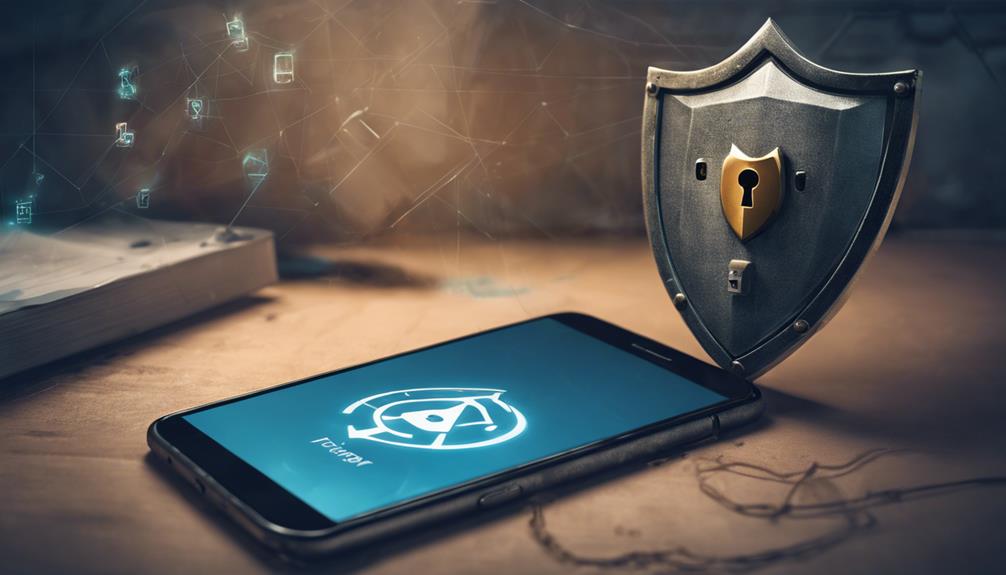Apple's iOS is equipped with robust security measures like strong encryption, strict App Store guidelines, and advanced features such as Touch ID and Face ID. It resists common signs of hacking and combats sophisticated state-sponsored threats through regular security updates. Users can enhance security by updating software, enabling two-factor authentication, and avoiding unofficial app sources. Two-factor authentication adds an extra layer of protection against breaches. iOS's emphasis on privacy and security makes it a secure platform against hackers. Further insights await on how iOS fortifies itself against cyber threats.
Key Takeaways
- iOS features strong encryption and strict security measures.
- Apple regularly releases security updates to counter threats.
- Two-factor authentication enhances iOS security against breaches.
- State-sponsored threats are countered by Apple's advanced security.
- Following essential security practices strengthens iPhone security.
Ios Security Measures Overview
Apple's iOS boasts a significant array of security measures designed to safeguard user data and protect against potential hacking threats. One important aspect of iOS security is its robust privacy settings. Users have precise control over their privacy, allowing them to manage app permissions, location services, and data sharing. By customizing these settings, users can restrict access to sensitive information, reducing the risk of unauthorized data breaches. Additionally, iOS incorporates strong encryption mechanisms that guarantee user data and communications remain secure from prying eyes.
Furthermore, Apple's strict App Store guidelines and review processes play an essential role in maintaining iOS security. By screening apps before they are made available to users, Apple helps prevent malicious software from infiltrating devices. Additionally, iOS devices come equipped with advanced security features like Touch ID, Face ID, and Find My iPhone, which provide an extra layer of protection against unauthorized access.
Through these thorough security measures, iOS continues to prioritize user privacy and data protection.
Common Signs of Iphone Hacking

If you notice suspicious activity alerts or experience unexplained battery drain on your iPhone, these could be common signs of hacking.
Keep an eye out for unexpected messages or sluggish performance, as these may indicate unauthorized access to your device.
Sudden changes in settings or unusual behavior like apps opening on their own should also raise red flags about potential hacking attempts.
Suspicious Activity Alerts
Signs indicating potential iPhone hacking, such as unexpected messages, device sluggishness, and unknown messages being sent, serve as important suspicious activity alerts for users to remain vigilant against unauthorized access. These signs can compromise the privacy of personal data stored on the device. If you notice any of these suspicious activities, it is vital to take immediate action to investigate and secure your iPhone.
| Suspicious Activity Alerts | |
|---|---|
| Unexpected Messages | Device Sluggishness |
| Unknown Messages Sent | Unexplained Battery Drain |
Remaining alert for any unusual behavior on your iPhone is essential in maintaining the security and privacy of your information. While most hacking attempts on iPhones are not through malware, staying cautious and promptly addressing any signs of potential hacking can help safeguard your data from unauthorized access. Remember, Apple regularly releases security updates to enhance the protection of iOS devices against hacking attempts.
Unexplained Battery Drain
One of the common indicators of potential iPhone hacking is unexplained battery drain on the device. If you notice a sudden and significant decrease in battery life without a clear cause, it could be a sign that hackers are running background processes on your device.
These unauthorized activities can lead to increased battery consumption as they exploit your iPhone for malicious purposes. Monitoring your battery usage and identifying any unusual spikes in power consumption can help you detect potential security breaches.
Be vigilant and check for unfamiliar apps or services running in the background that may be draining your battery due to hacking attempts. Protecting your device from such intrusions is essential to safeguarding your personal data and ensuring the security of your iPhone.
If you suspect hacking due to unexplained battery drain, consider investigating further to prevent any potential unauthorized access to your sensitive information.
State-Sponsored Hacking Threats

State-sponsored entities pose a significant threat to the security of iOS devices through sophisticated hacking attempts designed to target specific individuals or organizations. These state-sponsored hacking threats are often behind the scenes, employing advanced techniques to bypass Apple's security measures. Their primary goals include information gathering and causing disruptions.
By exploiting vulnerabilities in iOS, these hackers can gain unauthorized access to devices, potentially compromising sensitive data. Apple recognizes the importance of these threats and continually releases security updates to counter state-sponsored hacking attempts and safeguard user information.
Staying vigilant against these sophisticated adversaries is essential for both Apple and its users to maintain the integrity and security of iOS devices. By understanding the risks posed by state-sponsored hacking threats, individuals and organizations can take proactive measures to enhance their iOS security and protect their digital assets.
Importance of Regular Security Updates

Regular security updates play an essential role in safeguarding iOS devices against potential cyber threats. By updating your device regularly, you guarantee that any vulnerabilities in the system are promptly addressed, reducing the risk of unauthorized access by hackers.
These updates provide vital security patches that enhance the overall protection of your device and help mitigate the evolving landscape of cyber risks.
Update Frequency Importance
Consistent and timely installation of security updates plays a critical role in safeguarding iOS devices against emerging cyber threats and vulnerabilities. Apple's frequent updates are essential to patch vulnerabilities and enhance the security of iOS devices, ensuring the privacy and security of user data. Delaying or ignoring these updates can leave devices vulnerable to hacking attempts, jeopardizing sensitive information. By updating iOS promptly, users equip their devices with the latest security features and protocols, strengthening their defense against cyber threats.
| Importance of Update Frequency |
|---|
| 1. Patch Vulnerabilities |
| 2. Enhance Security |
| 3. Protect User Data |
Regular updates not only protect against known threats but also fortify devices against new security risks. Users must prioritize staying up to date with installations to maintain the security integrity of their iOS devices and safeguard their privacy effectively.
Vulnerability Patching Necessity
Timely installation of security updates is imperative for mitigating vulnerabilities and safeguarding iOS devices against potential hacking threats. Failing to update devices promptly can expose them to known security flaws that malicious actors can exploit.
Security updates provided by Apple not only address existing vulnerabilities but also bolster the overall security of iOS devices. Hackers often target devices with outdated software, making regular security updates a critical defense mechanism against potential attacks.
Regular security updates are essential for patching vulnerabilities and protecting devices. Failure to install updates promptly can leave devices vulnerable to exploitation.
Security updates not only fix existing vulnerabilities but also enhance overall security. Timely updates are vital to defend against hackers who target outdated software versions.
Security Patch Benefits
Security patch benefits are essential in upholding the robust security posture of iOS devices, particularly through the consistent application of updates. Regular security updates from Apple play a vital role in safeguarding iOS devices against known vulnerabilities and security threats. These patches address potential weaknesses within the iOS system, enhancing data protection and privacy for users. Timely installation of security patches is vital to guarantee the integrity and security of iOS devices, as ignoring updates can expose devices to hacking, malware, and other cyber threats.
Furthermore, Apple's commitment to releasing frequent security patches highlights their dedication to enhancing iOS security and user protection. By staying up to date with security updates, users can actively mitigate risks and strengthen the defense mechanisms of their devices.
Implementing additional security measures such as two-factor authentication alongside regular security patches further fortifies the overall security posture of iOS devices, providing users with a layered approach to protect their sensitive information.
Essential Security Practices for Iphone Users

Utilizing essential security practices is paramount for iPhone users to safeguard their devices and personal information from potential cyber threats.
To enhance your iPhone's security, consider the following best practices:
- Regularly update your iPhone's software to receive the latest security patches and protections against potential vulnerabilities.
- Enable two-factor authentication for your Apple ID to add an extra layer of security to your account.
- Avoid downloading apps from unofficial sources to minimize the risk of malware and spyware infections on your device.
- Use strong and unique passwords for all your accounts, including your Apple ID and iCloud, to prevent unauthorized access.
Additionally, be cautious when connecting to public Wi-Fi networks, as they may be prone to hacking attempts that can compromise your iPhone's security.
Enhancing Iphone Security With Two-Factor Authentication

Improving iPhone security through the implementation of two-factor authentication is an essential step in safeguarding personal information and preventing unauthorized access.
Two-factor authentication adds an extra layer of security by requiring a second form of verification, reducing the risk of unauthorized access to your iPhone and Apple accounts. This method helps prevent unauthorized entry even if someone has obtained your password.
To enable two-factor authentication on iOS, navigate to Settings, tap on your name, select Password & Security, and then Turn on Two-Factor Authentication. Once activated, you will receive a verification code on trusted devices or phone numbers when signing in from a new device or browser.
Frequently Asked Questions
Does Ios Protect Against Hackers?
iOS devices are safeguarded by robust security measures, regular software updates, a closed ecosystem, strong encryption, and a stringent app vetting process. Additional layers of protection like two-factor authentication and biometric features further fortify iOS against potential hacker threats.
Is Ios Security Safe?
In the domain of digital fortresses, iOS stands as a bastion of security. With robust encryption, vigilant updates, and a vigilant gatekeeping App Store, iOS security is a shield against cyber threats, ensuring user safety.
Is Ios Really More Secure Than Android?
When comparing iOS and Android security, iOS emerges as the more secure platform due to Apple's closed ecosystem, strict App Store guidelines, regular security updates, robust hardware encryption, and a lower susceptibility to vulnerabilities and cyberattacks.
Can Hackers See You Through Your Iphone?
Recent studies indicate that hackers cannot access your iPhone's camera or microphone without your knowledge. While rare cases of spyware exist, Apple actively patches vulnerabilities. To maintain security, avoid suspicious apps and update software regularly.
Conclusion
To sum up, the security measures in iOS are robust, but users should remain vigilant against potential hacking threats. Regular updates and two-factor authentication are key practices to enhance iPhone security.
Think of iPhone security like a fortress with multiple layers of protection, constantly reinforced to keep out unwanted intruders.
Stay informed, stay proactive, and keep your device safe from cyber threats.









